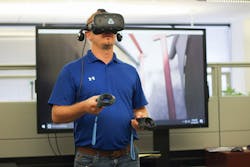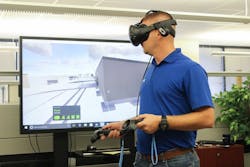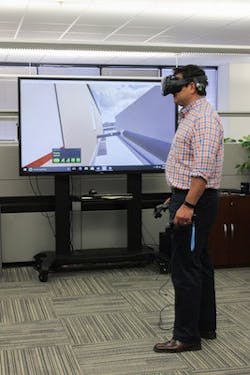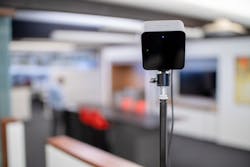Virtual Leap
About the author:
Jeremy Nakashima, P.E., is wastewater practice leader at Lockwood, Andrews & Newnam, Inc. Nakashima can be reached at [email protected].
No plans or models—traditional or digital—truly can show clients how a water treatment plant, a pump station or a wastewater facility will look, feel and function before it is built. While computer-aided design (CAD), 3D modeling and building information modeling (BIM) show clients project spaces and systems, they still only provide them with limited knowledge of the finished facility. What if you could bring a project to life and help the client experience the facility? With virtual reality (VR), that now is possible.
Better Visualization
Engineers can use VR during the design process to better visualize a model. If a picture is worth a thousand words, VR is worth a million. By accessing a model directly from Revit, the engineer or designer is just a few clicks away from a virtual walk-through. By using this tool, engineers can test ideas and concepts as early as the 30% design stage. They can get a better idea of the scale and size of the different components in the facility, the placement of the equipment from an operations and maintenance standpoint, the location and orientation of the pipes and valves, the accessibility of the various spaces, and more.
(Watch a video about VR for engineers.)
As the project team goes through the 30, 60, 90 and 100% design phases, they can periodically conduct a VR walk-through to evaluate the design and make necessary changes. If need be, the team can even do a walk-through daily, given how quickly the VR model can be setup. Also, teams from various disciplines—such as architectural, structural, mechanical and electrical—can review the model together during the different design stages, resolve potential conflicts, make corrections and ensure the design is functioning as intended. Integrating these quality assurance and quality control (QA/QC) checks also will enable the design process to become more streamlined and efficient.
Better Client Feedback
VR allows the client to give meaningful feedback throughout the different design stages. While architects, engineers and contractors are trained to visualize the model from 2D drawings, not all clients are trained to read 2D drawings and sometimes have a hard time visualizing. Even the best 2D drawings require a client to use their imagination to see how the new facility will look after completion. This is one of the reasons why clients give feedback during the later stages of design or want corrections after construction is underway. By this time, it becomes costly to make major design changes.
Two years ago, Lockwood, Andrews & Newnam (LAN) designed a new wastewater treatment facility for a client in Conroe, Texas, using Revit. At the time, the firm did not use VR technology, so instead it created a fly-through. It was immersive to an extent, as it gave the operator a 3D representation using images from the Revit model. During the review meeting, the client told the firm it was helpful to see the 3D images and gave some feedback. Fast forward two years—LAN had its second 75% design review (the project was delayed due to a change in the site location). This time, VR was used as a review tool. Halfway through the demonstration, the client decided to put on the VR headset and take a walk-through of the plant. He showed the designers where he wanted the equipment, where he needed staircases, what was done right and what was done wrong. It was exactly the kind of feedback needed.
“You can look at plans all day long, but when you actually get to walk through the plant before it is built, you can see things you would like to change or do differently.” said Greg Hall, city of Conroe wastewater treatment plant superintendent. “VR is much more eye-opening and gives a much better spatial awareness of where everything is located. One of my favorite things when I did the VR walk-through was that I could look 100 ft above a structure and 100 ft below the structure. I could walk around every structure and see what it was going to look like and identify potential issues.”
Reduced Change Orders
Change orders are challenges in every public infrastructure project, especially late in the design or after construction has started. There are many projects that have too many change orders, which have disrupted the project’s schedule and budget.
This can be prevented by using VR in the two ways mentioned previously: First, during the internal review process with teams from multiple disciplines to ensure the design is functioning without conflicts and is efficient from a maintenance and operations standpoint; and second, during the client review at various stages of design. By implementing these QA/QC checks through VR, design glitches and unforeseen problems are seen and caught early, long before the project reaches the construction stage. This significantly minimizes the number of change orders, resulting in reduced time to deliver the project and, ultimately, cost savings for the client.
Enhanced Collaboration With Contractors
In addition to enhanced teamwork and client collaboration, designers could use VR as a powerful tool to communicate the design intent to contractors before bids even are submitted. During the bidding process, the designer could give a VR presentation or provide Google Cardboards to potential contractors at the pre-bid conference to give them a better feel for the scope of the project. This could reduce the bidding price and save money for the owner.
Once a contractor is selected, construction teams can further explore the proposed facility before a spade of dirt is turned. They can walk through the entire facility virtually from different geographical locations, understand project complexities, identify the risks and associated costs before construction begins, and spot construction challenges that they would not have been able to identify on a 2D drawing or a 3D model. They can confirm whether the designed facility resembles what they had in mind.
But what happens once construction starts and changes are required at the jobsite? The design and construction professionals can simply put on a headset, look at the model, make the necessary changes and ensure that the rest of the project works smoothly.
For Marketing Purposes
Finally, firms can use VR as a marketing tool. Giving a potential client an a VR experience that fits the public agency’s specific needs can be a competitive advantage. Over the last year, LAN already has had success using VR for client presentations.
Other ways of using VR as a marketing tool include showing a demo in tradeshow booths, using them in marketing campaigns, giving clients free Google Cardboards, offering free VR downloads on a website, and showcasing projects on YouTube with its 360-degree video support tool.
Conclusion
Though VR still is a relatively new tool for the engineering industry, firms working on public infrastructure projects increasingly are integrating it into their design processes. It clearly has evolved into a powerful tool with numerous benefits. Far more than just a new technology, VR increasingly is being leveraged by project teams to add value, increase stakeholder engagement, enhance communication, resolve project challenges and, ultimately, improve project outcomes.
Behind the Goggles
By Jeremy Nakashima
I originally thought of VR more as a toy from the gaming industry, and never considered its potential uses as a tool that could be used in the civil engineering profession. My first experience with VR happened in June 2017 while I was interacting with architects at our parent firm. (The architecture industry has been using VR for a few years, but this technology still is in its beginning stages in the civil engineering industry.) When these architects told me how they were using VR for their projects, I decided to take a test drive with a couple of our water and wastewater projects. We already had completed the design of these projects in Revit, the software platform that our firm uses. I was amazed at how quickly the Revit file could be converted into a VR-compatible file format. The entire process literally took only 10 minutes.
Once I put on the VR headset and walked through the plant in the virtual space, I knew it would be a game-changer for our firm. After I finished the walk-through and reflected on my experience, VR’s possibilities excited me.





